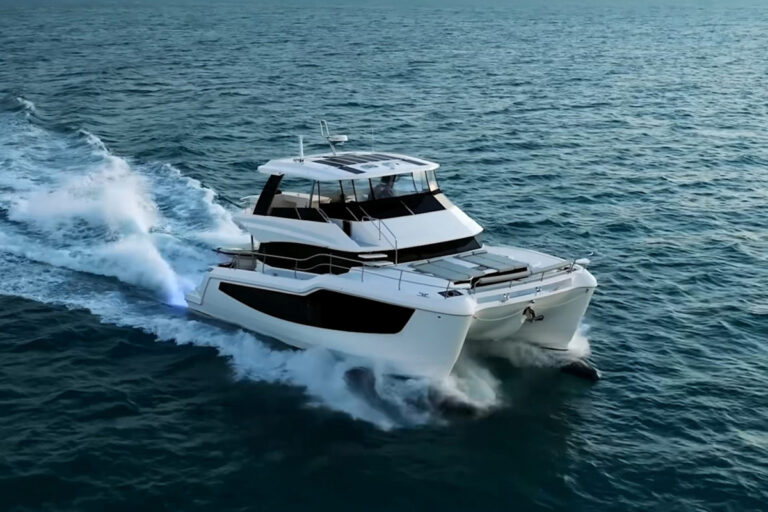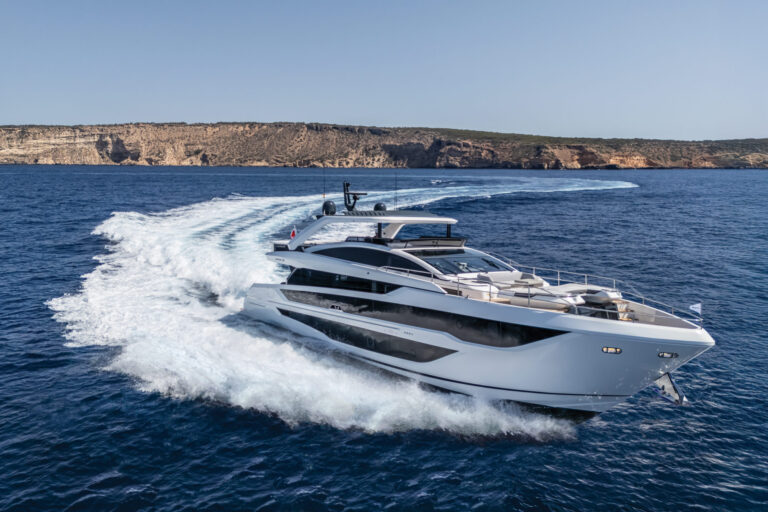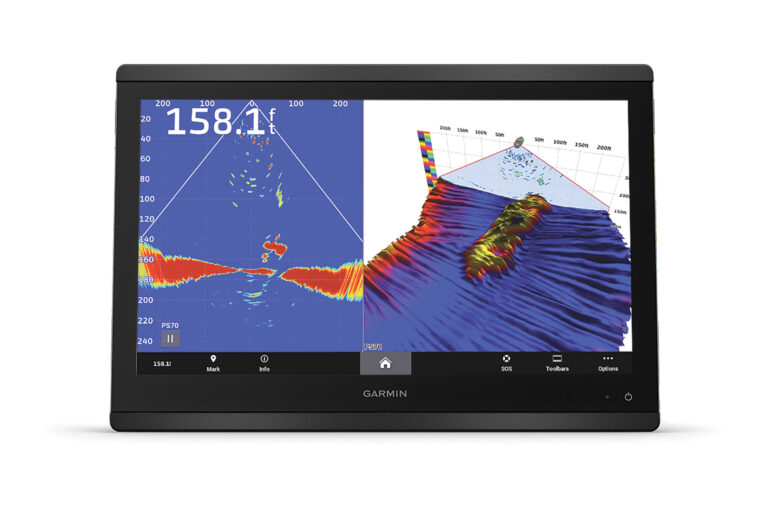On a beautiful sunlit Chesapeake afternoon, I began my evaluation of the Antares 13.80 cruiser by taking a walk-a comfortable walk from the cockpit aft along side decks wide enough to let me stride purposefully and quickly forward to cast off the bow lines. Given the growing number of designs that sacrifice workable, safely walkable side decks for wide-beam deckhouses that leave little or no footing along the sides, this was a most refreshing way to begin a test ride.
Glen Winter, a dealer for Beneteau’s power and sailing yachts, bumped the throttles into forward and the Antares moved quickly out of the slip. I walked aft across the foredeck and down the side decks, also with great assurance, because this boat had optional teak planking on those decks. The precisely laid planking, which is standard in the aft cockpit, on the coamings and is also used as treads on the stairway to the flying bridge, was carefully bedded and sanded perfectly smooth. I couldn’t help admiring the craftsmanship, particularly the way in which the planks gradually angled inward around the curved walls of the curved foredeck cabin top-very nice work indeed.
Glancing forward, I noticed our bow closing quickly with a boat on the opposite side of the narrow fairway. But Winter shifted the starboard throttle aft and added a burst of bow thruster, swinging the nose more forcefully into the wind that was now coming across our beam from right to left. Traditionalists will argue otherwise, but it is my firm belief that every yacht should have a bow thruster as standard equipment-as this one does.
When you stop and think about it, a yacht that is easily maneuverable in tight quarters and laid out for safe and easy movement on deck-with very stout double safety rails running from the bow to the steps leading down into the aft cockpit, and with well placed grabrails to steady your passage down the steps-is the very definition of a well-found cruiser. Those rails extend up the flying bridge stairs, and completely encircle three sides of the bridge, including the sunpad on the after end of the bridge deck overhang. If you’re worried about guests or children moving around up top while under way, simply unlatch and close the long hatch to port to cover the stairway access port. Very sensible, to my way of thinking.
Although the upper helm is set to port, the helmsman’s chair is very near the centerline, giving excellent views all around. The console is large enough to house vital instruments with room left over portside of the sport-type wheel to mount a multifunction radar/chart plotter. The bench seat to port wraps around behind the helm, ending in a console complete with a small freshwater sink; storage beneath that will accept an optional fridge to minimize those trips below for drinks. Better yet, the bench is long enough to double as a sun pad, in case your mate wants to hang out but has had enough navigation duties for one day.
Handling under way is straightforward and predictable, although I was very surprised to discover that, even in the last 150 rpm, I still experienced a surge of acceleration when I advanced the throttles. The Antares 13.80 turns smoothly with only a slight bank inward. Its substantial flare, more typical of a Carolina sportfisherman than a cruiser, should keep the foredeck and side decks very dry in all but the worst conditions. At a cruising speed of 24 knots, this yacht should have a range of approximately 270 nautical miles with a 10 percent fuel reserve, based on Beneteau’s data guidelines.
Operating the Antares 13.80 from the flying bridge will be the first option for most owners, but Beneteau’s designers and engineers included a lower helm station for those days when the family is willing and ready but the weather is less so. Equipped with a double helm bench and a larger console for a wider range of instruments, the lower helm is situated well forward for optimal visibility through large glass windows and sliding side windows. With the wooden blinds raised and the fabric curtain tied back, the helmsman’s visibility is outstanding in all directions, save for one small angle where the flying bridge stairs are supported. Even then, it’s easy to look around by stepping across the cabin and looking aft.
Sumptuous leather, flawless woodwork and gleaming stainless steel blend visually in the main saloon, creating a luxurious living environment that is at once modern and traditional. Lockers and doors are fitted with great care, opening smoothly to reveal, among other things, dedicated liquor storage, a below-the-counter refrigerator, and space forward that will accept an optional microwave. The gas stove, supplied from a ventilated locker in the aft cockpit, is located near the portside sliding window for optional ventilation, and is also equipped with a glass cover that flips up to form a spatter screen. The saloon’s hardwood soles are satin finished, notched to accept thin rubber strips that run the length of the cabin on four-inch centers, and protrude above the floor to provide good non-slip protection.
Two staterooms tuck up under the forward end of the saloon sole on the accommodations level, both with privacy doors and beautiful wood bulkheads-fit for guests and family members alike. They also have outstanding headroom and a comfortable seat for dressing, plus twin beds that convert easily with a filler into long double berths. The day head to port serves both cabins. A large island double is the focal point of the master stateroom in the bow, which includes two hanging lockers (as opposed to the single lockers in the other staterooms), two dressing stations and an en suite head compartment with a cylindrical Plexiglas shower door.
There’s a lot to like about the Antares 13.80 from Beneteau, a company that’s been building powerboats in France since 1908 but is better known in this country for its line of popular sailboats. Don’t let that stop you from examining this comfortable, well-found yacht more closely. It’s designed and built for the rugged open waters of the Bay of Biscay, so it should handle your local waters and the distant ports you want to explore with great aplomb.
Contact: Beneteau USA, (843) 629-5300; www.beneteauusa.com.








